Get to know our highly effective nucleating agents for your EPS!
With VISCOWAX®, Innospec Leuna supplies efficient nucleation agents for expandable polystyrene (EPS), trusted by leading producers worldwide. Contact us for expert guidance — we’ll help you choose the ideal nucleation agent for your styrene suspension polymerization.
EPS
Expandable polystyrene beads are produced by suspension Polymerization (pearl Polymerization) and are impregnated with a blowing agent, preferably pentane.
Products made of EPS are mainly used for insulation in the building industry and for packaging or drinking cups. The production of these products is normally split in two production lines, production of expandable polystyrene beads and production of EPS-foams.
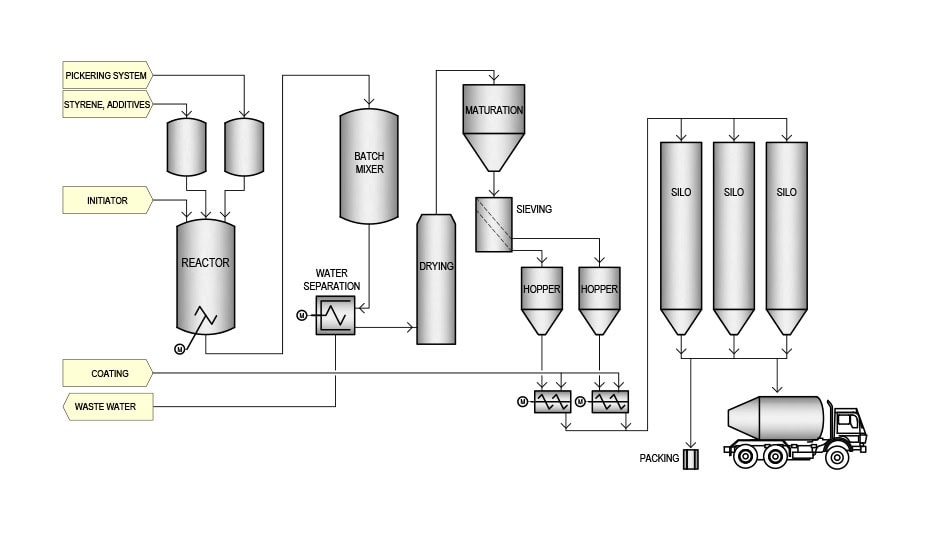
Production of expandable polystyrene beads
The expandable PS-beads can be produced by a two-steps or one-step process. The most common one-step process involves the impregnation with the blowing agent during Polymerization. In the two-step process the polystyrene is first produced in a suspension Polymerization. The polystyrene is then impregnated with the blowing agent under pressure in another plant.
Suspension Polymerization
The Polymerization of styrene occurs in a stirred vessel, where the monomers are finely dispersed in water, usually at a phase ratio of 40:60 to 60:40. The suspension is stabilized with additives, called a “pickering system”. The radical Polymerization it started with initiators.
To achieve a fine and homogeneous cell structure in the final product, a nucleating agent is also added. Other additives may be used, including crosslinking additives, flame retardants, chain regulation agents, buffers. The Polymerization is often divided in two stages. In the first stage the main Polymerization takes place.
During this phase, the dispersion of the nucleating agent occurs. At the end of the first stage the particles and the particle sizes are more or less formed (identity point). The reactor is then closed, and the blowing agent is dosed into the closed vessel.
By increasing the temperature to 115 – 130°C, the second initiator with high temperature sensitivity starts the final Polymerization. At the end of the Polymerization the temperature and pressure are reduced in a controlled way. This achieves optimal pentane distribution and avoids unwanted pentane condensations.
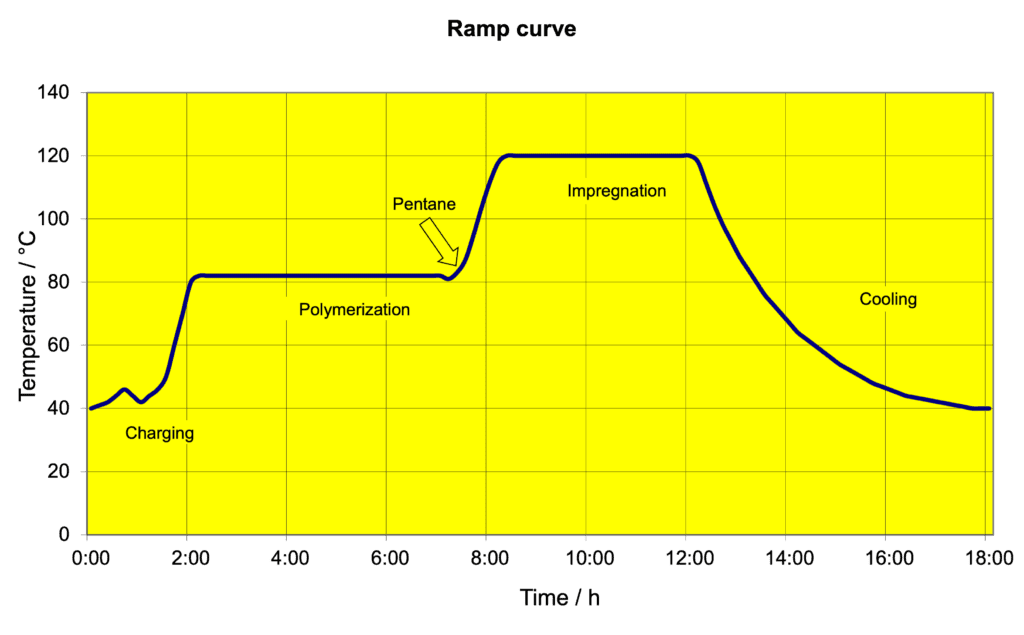
The cooled suspension is transferred to a buffer vessel, where the batches are homogenized. The water is separated from the polymer and the polymer is then transferred to a drier. There, the polymer is gently dried with air. Maturation hoppers are often used to provide homogeneous distribution of the blowing agent in the polymer beads.
Further processing steps may include sieving, to obtain specific particle size fractions, and coating with, for example, antistatic agents, anti-lumping agents or additives to increase pentane permeability (shorten cycle time).
Production of EPS-foams
Step 1:
Pre-expansion of EPS beads
Step 2:
Maturing or temporary storage
Step 3:
Moulding or
blocking
Pre-expansion of EPS-foams
During the pre-expansion process, the EPS-beads are heated with saturated steam. This treatment initiates two very important processes:
- Softening the EPS (temperature above glass transition temperature, Tg)
- Evaporation and expansion of pentane
- The EPS beads expand during this process by the factor of 40 – 80.
At this stage the finely dispersed nucleation agent (VISCOWAX®) takes effect. The forming of pentane gas bubbles occurs preferably at the surface of the fine VISCOWAX® crystals (nuclei)
The number and size of pentane bubbles can therefore be adjusted. As a result, EPS-beads with fine and homogeneously distributed bubbles are formed. The pre-foaming process can be done either continuously or discontinuously.
The following pictures of cut beads show the effect of nucleation agent on cell structure in expanded polystyrene:
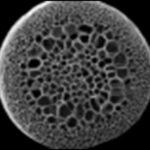
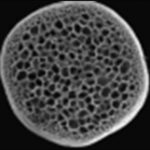
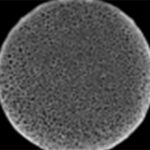
Maturation
Storage is required after pre-foaming to cool down and balance the pressure difference between the bubbles in the EPS-beads and the environment (air migrates into the beads).
Final foaming process
After the maturation the EPS-beads can be used for the production of the final products. Normally, the EPS-beads are filled into a perforated mould and again treated again with steam. The EPS-beads expand again and weld together to homogeneous foam. After venting and cooling the EPS-article can be demoulded and further processed (e.g. by cutting) if necessary.
How does VISCOWAX® work?
- During suspension Polymerization the crystalline VISCOWAX® will be finely dispersed in the polystyrene beads.
- Based on the incompatibility of the VISCOWAX® in the amorphous polystyrene it develops microscopic crystals which act later as the nuclei for bubble forming.
- These fine VISCOWAX® crystals have a good compatibility with pentane and therefore the pentane migrates easily into the wax structure.
- During the expansion process, the formation of pentane bubbles is energetically preferred at the interfaces between VISCOWAX® crystals and polystyrene matrix.
- By this means homogenous, fine-core EPS pearls, characterized by short pre-foaming periods and particularly short pressure reduction periods, are obtained.
Advantages of VISCOWAX®
By using VISCOWAX® as nucleation agent a homogeneous fine cell structure can be obtained. This leads to mechanically stable, spherical beads with good insulation properties. The next two pictures show the macroscopic difference in bead appearance between good and bad nucleation effect.
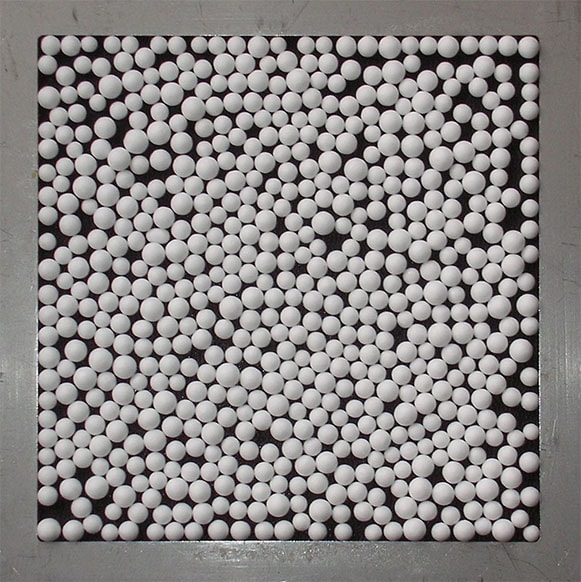
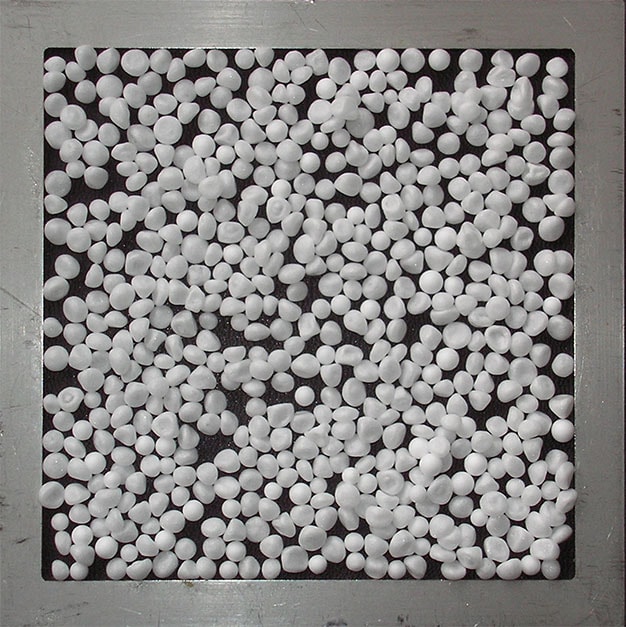

Safety and environment
VISCOWAX® has not been classified as a hazardous material in accordance with the Regulation (EC) No. 1272/2008 (CLP/GHS) and therefore does not require marking. The product does not contain heavy metals. lt is insoluble in water and has no harmful effect on fish and bacteria. Disposal of the product must be carried out in accordance with the local regulations.
Status under food legislation
EU: Listed in Annex I of Regulation (EU) 10/2011
(Ref. No. 80000)
USA: FDA CFR 21 §§ 177.1520 (c) 2.3, 175.300, 175.105
Form of delivery, packaging and storage
VISCOWAX® is shipped palletised (preferably 750 kg each) and shrink-wrapped as dustfree powder in PE sacks of 25 kg each. Shipment in bags of different sizes is possible by request. The product should be stored in its original packaging at room temperature in a dry place. lt must not be stored together with amines. Avoid direct sunlight and water contact.
FAQ
Innospec’s nucleating agents for EPS are based on special polymerized polyethylene wax with finetuned crystallinity. The nucleating agents are regularly produced grades within Innospec’s product portfolio.
Innospec Leuna, a leading producer of PE waxes, produces the nucleation agent in its own polymerization plant. The nucleating agents are standard grades within Innospec’s product portfolio.
Due to a finetuned polymerization technology, our nucleating agents are 100% competitive in performance to competition grades, like Polywax® or Xactowax®. You may expect high performance in question of e.g. cell homogeneity, mechanical stability, and insulation performance (Lambda-value)
Innospec’s nucleating agents are supplied as fine grain of about 0.5 mm particle size in average.
Yes, our nucleating agents are used worldwide by leading EPS producers. They are widely used as competitive alternative to other known nucleating agents, like Polywax® 1000, Xactowax® 1000 or Acculin® 1000. For a list of references, please contact us.
Let's Talk.
For further information and for recommendation of best solution for good nucleation performance in your EPS production, please contact us.


